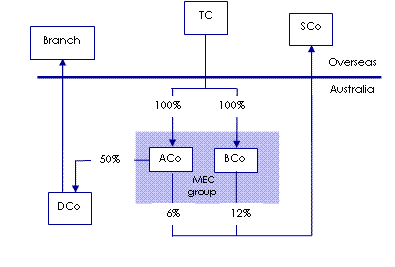Consolidation Reference Manual
You can still refer to the Consolidation reference manual for consolidation information that has not been impacted by changes in the legislation.
C6 International
C6-2 Worked example
C6-2-410 Treatment of conduit foreign income
Description
This example shows how the conduit foreign income of an entity that joins a consolidated or MEC group is treated as conduit foreign income of the head company. It also shows how the head company can use the conduit foreign income to pay non-resident shareholders unfranked dividends that are exempt from dividend withholding tax, including on-paying conduit foreign income received from another Australian corporate tax entity outside the consolidated or MEC group.
Commentary
The conduit foreign income of an entity that joins a consolidated or MEC group becomes conduit foreign income of the group's head company. Any conduit foreign income derived by subsidiary members is treated as being derived by the head company. The head company calculates the amount of conduit foreign income that is available to pay unfranked dividends to the non-resident shareholders of the group, free from dividend withholding tax. The head company is also able to on-pay a declared conduit foreign income amount that is received as a distribution from another Australian corporate tax entity outside the group.
Example
Facts
ACo and BCo are wholly-owned subsidiaries of TC, the top company. ACo and BCo are both eligible tier-1 companies. On 1 July 2008 they form a MEC group, jointly nominating ACo to be the provisional head company. ACo is the provisional head company at the end of the group's income year and so is taken to be the head company of the MEC group for the whole of its income year.
The head company's income year is 1 July to 30 June.
At the formation time, ACo holds a 6% foreign investment in SCo, so the dividends paid by SCo to ACo are not non-portfolio dividends. On 30 May 2008, ACo receives $2,500 in dividends from SCo.
ACo also owns 50% of DCo, an Australian corporate tax entity. DCo carries on business overseas through a branch (that is, a permanent establishment) and receives foreign branch income that is non-assessable, non-exempt income under section 23AH of the ITAA 1936. ACo has declared and distributed all the conduit foreign income it received from DCo before forming the MEC group on 1 July 2008.
BCo holds a 12% foreign investment (that is non-portfolio) in SCo, and on 30 May 2008 receives $5,000 in non-portfolio dividends from SCo. At 30 June 2008, BCo calculates its conduit foreign income to be $5,000.
No further foreign investments are made by ACo or BCo.
Figure 1: Foreign investments of MEC group

On 1 September 2008, SCo pays dividends of $4,400 to ACo and $8,800 to BCo. BCo incurs an expense of $2,000 on 1 October 2008 that relates to the dividends paid by SCo.
On 1 October 2008, DCo pays ACo an unfranked dividend of $20,000, of which $10,000 is a declared conduit foreign income amount.
On 31 December 2008, ACo and BCo both make distributions to TC. ACo pays a dividend of $12,000 and BCo pays one of $10,000. ACo, as the provisional head company, will be taken to have paid BCo's dividend to TC and will be required to provide the distribution statement to TC.
Calculation
Conduit foreign income of $5,000 received by BCo before joining the MEC group is treated as conduit foreign income of ACo as the provisional head company of the MEC group. At the joining time, ACo is also able to aggregate the total foreign investment holding and calculate conduit foreign income based on the group's 18% foreign investment in SCo. Therefore, all dividends received from SCo after the joining time will be treated as non-portfolio dividends.
Before making the distribution to TC, ACo (the provisional head company) calculates the conduit foreign income for the group at 31 December 2008 as follows:
- •
- ACo has a balance of conduit foreign income received from BCo of $5,000 at the joining time.
- •
- The dividends SCo paid to ACo and BCo totalling $13,200 are treated as being derived by ACo and added to the conduit foreign income amount.
- •
- The $2,000 expense incurred by BCo in relation to the dividends received from SCo reduces the conduit foreign income amount.
- •
- ACo adds to its conduit foreign income amount the received conduit foreign income amount of $10,000 included in the unfranked dividends received from DCo.
ACo has $26,200 of conduit foreign income available for distribution on 31 December 2008.
The unfranked dividend of $22,000 paid to TC on 31 December 2008 is declared to be 100% conduit foreign income.
ACo, as provisional head company, provides a distribution statement indicating the amount of the unfranked distributions that is declared to be conduit foreign income. TC will receive this amount free of withholding tax.
As ACo on-paid within the required timeframe the full amount of declared conduit foreign income it received as part of the unfranked distribution from DCo, this portion of the DCo dividend is treated is non-assessable, non-exempt income of ACo.
References
Tax Laws Amendment (Loss Recoupment Rules and Other Measures) Act 2005 , which repealed Subdivisions 717-J and 719-X and inserted Subdivisions 715-U and 802-A of the ITAA 1997
Explanatory Memorandum to the Tax Laws Amendment (Loss Recoupment Rules and Other Measures) Bill 2005, Chapter 5
History
Section C6-2-410 first published 30 June 2009.
Proposed changes to consolidation
Proposed changes to consolidation announced by the Government are not incorporated into the Consolidation reference manual until they become law. In the interim, information about such changes can be viewed at:
- •
- http://assistant treasurer.gov.au (Assistant Treasurer's press releases)
- •
- www.treasury.gov.au (Treasury papers on refinements to the consolidation regime).
Current at 30 June 2009
